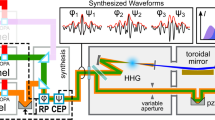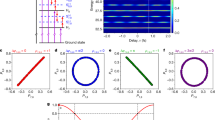Abstract
Generating attosecond pulses has required a radically different approach from previous ultrafast optical methods. The technology of attosecond measurement, however, is built on established methods of characterizing femtosecond pulses: the pulse is measured after it has left the region where it was produced. We offer a completely different approach: in situ measurement. That is, we integrate attosecond-pulse production and measurement in a manner that can be applied to many high-order nonlinear interactions. To demonstrate this approach, we combine a low-intensity (<10−3) second-harmonic beam with the fundamental beam, to gently perturb the production process without significantly modifying it. The attosecond-pulse duration is read from the modulation of the even-harmonic signal as a function of the two-field delay. Increasing the second-harmonic intensity slightly (<10−2), we extend measurement to control. We demonstrate control by manipulating the high-harmonic spectrum with high efficiency.
This is a preview of subscription content, access via your institution
Access options
Subscribe to this journal
Receive 12 print issues and online access
$209.00 per year
only $17.42 per issue
Buy this article
- Purchase on Springer Link
- Instant access to full article PDF
Prices may be subject to local taxes which are calculated during checkout






Similar content being viewed by others
References
Corkum, P. B. Plasma perspective on strong-field multiphoton ionization. Phys. Rev. Lett. 71, 1994–1997 (1993).
Lewenstein, M., Balcou, Ph., Ivanov, M. Yu., L’Huillier, A. & Corkum, P. B. Theory of high-harmonic generation by low frequency laser fields. Phys. Rev. A 49, 2117–2132 (1994).
Itatani, J. et al. Tomographic imaging of molecular orbitals. Nature 432, 867–871 (2004).
Lein, M., Hay, N., Velotta, R., Marangos, J. P. & Knight, P. L. Role of the intermolecular phase in high harmonic generation. Phys. Rev. Lett. 88, 183903 (2002).
Kanai, T., Minemoto, S. & Sakai, H. Quantum interference during high-order harmonic generation from aligned molecules. Nature 435, 470–474 (2005).
Vozzi, C. et al. Controlling two-center interference in molecular high harmonic generation. Phys. Rev. Lett. 95, 153902 (2005).
Antoine, Ph., L’Huillier, A. & Lewenstein, M. Attosecond pulse trains using high-order harmonics. Phys. Rev. Lett. 77, 1234–1237 (1996).
Hentschel, M. et al. Attosecond metrology. Nature 414, 509–513 (2001).
Itatani, J. et al. Attosecond streak camera. Phys. Rev. Lett. 88, 173903 (2002).
Quéré, F., Itatani, J., Yudin, G. L. & Corkum, P. B. Attosecond spectral shearing interferometry. Phys. Rev. Lett. 90, 073902 (2003).
Tzallas, P., Charalambidis, D., Papadogiannis, N. A., Witte, K. & Tsakiris, G. D. Direct observation of attosecond light bunching. Nature 426, 267–271 (2003).
Mairesse, Y. et al. Attosecond synchronization of high-harmonic soft x-ray. Science 302, 1540–1543 (2003).
Sekikawa, T., Kosuge, A., Kanai, T. & Watanabe, S. Nonlinear optics in the extreme ultraviolet. Nature 432, 605–608 (2004).
Cormier, E. Self-referencing, spectrally, or spatially encoded spectral interferometry for the complete characterization of attosecond electromagnetic pulses. Phys. Rev. Lett. 94, 033905 (2005).
Shapiro, M. & Brumer, P. Laser control of product quantum state populations in unimolecular reactions. J. Chem. Phys. 84, 4103–4104 (1986).
Dupont, E., Corkum, P. B., Liu, H. C., Buchanan, M. & Wasilewski, Z. R. Phased-controlled currents in semiconductors. Phys. Rev. Lett. 74, 3596–3599 (1995).
Bhat, R. D. R. & Sipe, J. E. Optically injected spin currents in semiconductors. Phys. Rev. Lett. 18, 5432–5435 (2000).
Muller, H. G., Bucksbaum, P. H., Schumacher, D. W. & Zavriyev, A. Above-threshold ionization with a two-color laser field. J. Phys. B 23, 2761–2769 (1990).
Yin, Y., Chen, C., Elliot, D. S. & Smith, A. V. Asymmetric photoelectron angular distributions from interfering photoionization processes. Phys. Rev. Lett. 69, 2353–2356 (1992).
Eichmann, H. et al. Polarization-dependent high-order two-color mixing. Phys. Rev. A 51, R3414–R3417 (1995).
Andiel, U., Tsakiris, G. D., Cormier, E. & Witte, K. High-order harmonic amplitude modulation in two-color phase-controlled frequency mixing. Europhys. Lett. 47, 42–48 (1999).
Bartels, R. et al. Shaped-pulse optimization of coherent emission of high-harmonic soft X-rays. Nature 406, 164–166 (2000).
Lee, D. G., Kim, J. H., Hong, K. H. & Nam, C. H. Coherent control of high-order harmonics with chirped femtosecond laser pulses. Phys. Rev. Lett. 87, 243902 (2001).
Pfeifer, T. et al. Spatial control of high-harmonic generation in hollow fibers. Opt. Lett. 30, 1497–1499 (2005).
Kitzler, M. & Matthias, L. Spatial control of recollision wave packets with attosecond precision. Phys. Rev. Lett. 95, 253001 (2005).
Watanabe, S., Kondo, K., Nabekawa, Y., Sagisaka, A. & Kobayashi, Y. Two-color phase control in tunneling ionization and harmonic generation by a strong laser field and its third harmonic. Phys. Rev. Lett. 73, 2692–2695 (1994).
Kim, J. I. et al. Highly efficient high harmonic generation in an orthogonally polarized two-color laser field. Phys. Rev. Lett. 94, 243901 (2005).
Ivanov, M., Corkum, P. B., Zuo, T. & Bandrauk, A. Routes to control of intense-field atomic polarizability. Phys. Rev. Lett. 74, 2933–2936 (1995).
Salieres, P., L’Huillier, A. & Lewenstein, M. Coherence control of high-order harmonics. Phys. Rev. Lett. 74, 3776–3779 (1995).
Kane, D. J. & Trebino, R. Characterization of arbitrary femtosecond pulses using frequency-resolved optical gating. IEEE J. Quantum Electron. 29, 571–572 (1993).
Weckenbrock, M. et al. Fully differential rates for femtosecond multiphoton double ionization of Neon. Phys. Rev. Lett. 92, 213002 (2004).
Rudenko, A. et al. Correlated multielectron dynamics in ultrafast laser pulse interactions with atoms. Phys. Rev. Lett. 93, 253001 (2004).
Niikura, H. et al. Probing molecular dynamics with attosecond resolution using correlated wave packet pairs. Nature 421, 826–829 (2003).
Tong, X. M., Zhao, Z. X. & Lin, C. D. Probing molecular dynamic at attosecond resolution with femtosecond laser pulses. Phys. Rev. Lett. 91, 233203 (2003).
Milosevic, N., Corkum, P. B. & Brabec, T. How to use lasers for imagine attosecond dynamics of nuclear processes. Phys. Rev. Lett. 92, 013002 (2004).
Smirnova, O., Spanner, M. & Ivanov, M. Yu. Coulomb and polarization effects in syb-cycle dynamics of strong field ionization. J. Phys B 39, s307–s321 (2006).
Smirnova, O., Yakovlev, V. & Ivanov, M. Yu. Use of electron correlation to make attosecond measurements without attosecond pulses. Phys. Rev. Lett. 94, 213001 (2005).
Acknowledgements
The authors wish to thank D. Zeidler and M. Gertsvolf for discussions and experimental help. Financial support by the Israeli Rothschild foundation and NSERC is gratefully acknowledged.
Author information
Authors and Affiliations
Corresponding authors
Ethics declarations
Competing interests
The authors declare no competing financial interests.
Rights and permissions
About this article
Cite this article
Dudovich, N., Smirnova, O., Levesque, J. et al. Measuring and controlling the birth of attosecond XUV pulses. Nature Phys 2, 781–786 (2006). https://doi.org/10.1038/nphys434
Received:
Accepted:
Published:
Issue Date:
DOI: https://doi.org/10.1038/nphys434
This article is cited by
-
Observation of interband Berry phase in laser-driven crystals
Nature (2024)
-
Attosecond Physics in a Nutshell
Resonance (2024)
-
Light emission from strongly driven many-body systems
Nature Physics (2023)
-
Photon-statistics force in ultrafast electron dynamics
Nature Photonics (2023)
-
Attosecond field emission
Nature (2023)



